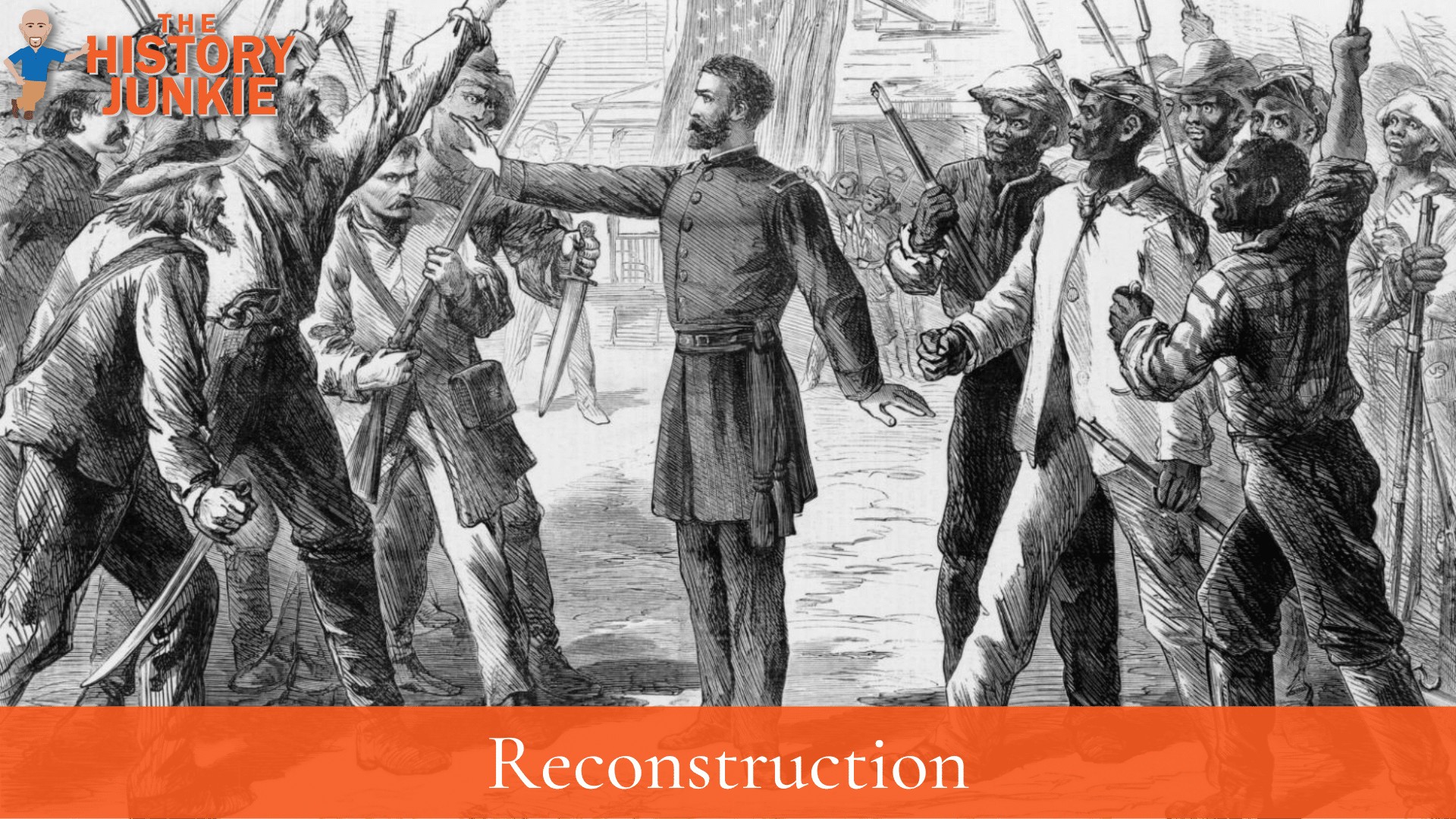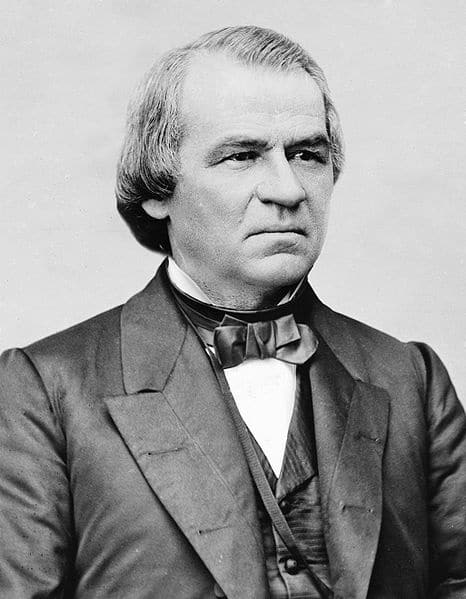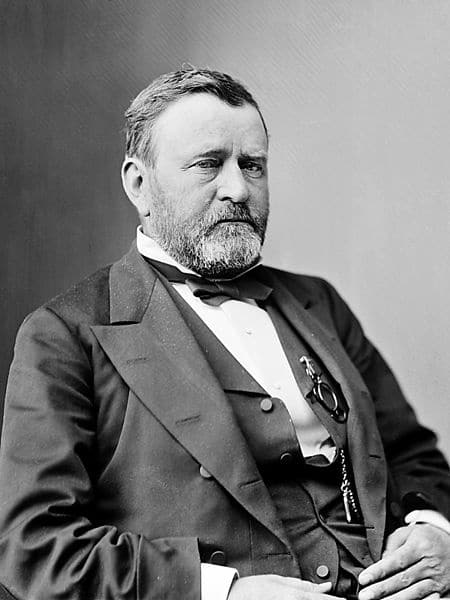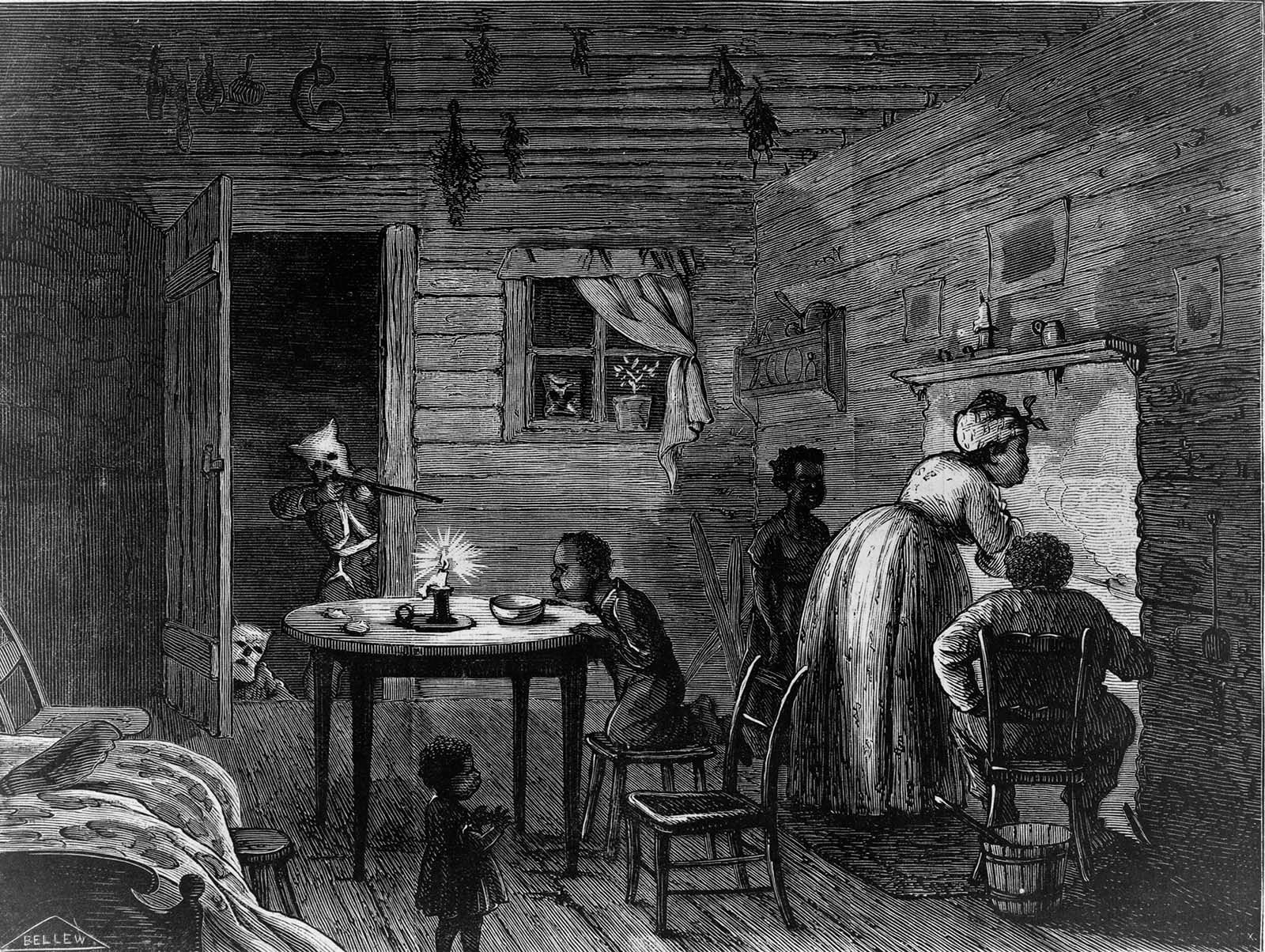Reconstruction was the attempt from 1863 to 1877 in American history to resolve the issues of the Civil War when both the Confederacy and slavery were destroyed, and the Constitution was expanded by three amendments that strengthened the rights of citizens.

Reconstruction addressed the return of the Southern states that had seceded, the status of ex-Confederate leaders, and the Constitutional and legal status of the African-American Freedmen (newly freed ex-slaves).
Violent controversy arose over how to accomplish those tasks, and by the mid-1870s, Reconstruction had failed to equally integrate the Freedmen into the legal, political, economic, and social system.
"Reconstruction" is also the common textbook name for the entire national history from 1865 to 1877.
Reconstruction came in three phases. Presidential Reconstruction 1863-66 was controlled by Presidents Abraham Lincoln and Andrew Johnson, with the goal of speedily reuniting the country.
Their moderate programs were opposed by the Radical Republicans, a political faction that gained power after the 1866 elections and began Radical Reconstruction, 1866-1873, emphasizing civil rights and voting rights for the Freedmen.
A Republican coalition of Freedmen, Carpetbaggers, and Scalawags controlled most of the southern states.
In the so-called Redemption, 1873-77, white supremacist Southern Democrats (calling themselves "Redeemers") defeated the Republicans and took control of each southern state, marking the end of Reconstruction.
Policy Issues

There were conflicting theories of what the national government could and should do to restore the South to a normal status. The key constitutional provision was the national government must guarantee to every state a "republican form of government."
Exactly what that meant was the issue. Radical Republican Charles Sumner argued that secession had destroyed statehood alone, but the Constitution still extended its authority and its protection over individuals, as in the territories.
Thaddeus Stevens and his followers viewed secession as having left the states in a status like newly conquered territory.
Congress rejected Johnson's argument that he had the war power to decide what to do since the war was now over.
Congress decided it had the primary authority to decide because the Constitution said Congress had to guarantee each state a republican form of government; the issue became how the core political values of republicanism should operate in the South.
President Abraham Lincoln was the leader of the moderate Republicans and wanted to speed up Reconstruction and reunite the nation as soon as possible. Lincoln formally began Reconstruction in late 1863 with his Ten Percent plan, which went into operation in several states but which Radicals opposed.
Lincoln vetoed the Radical plan, the Wade-Davis Bill of 1864. The opposing faction of Radical Republicans was much more skeptical of Southern intentions and demanded far more stringent federal action. Congressman Thaddeus Stevens and Senator Charles Sumner led the Radical Republicans.
After Lincoln's assassination, President Andrew Johnson switched from the Radical to the moderate camp. He, too, favored voting rights for the 170,000 black veterans.
Republican leaders agreed that slavery and the Slave Power had to be permanently destroyed and that all forms of Confederate nationalism had to be suppressed.
Moderates said this could be easily accomplished as soon as Confederate armies surrendered and the Southern states repealed secession and ratified the Thirteenth Amendment (which abolished slavery), all of which happened by September 1865, when Johnson felt Reconstruction was finished.

By 1866, however, Johnson, with no party affiliation, broke with the moderate Republicans and aligned himself more with the Democrats who opposed equality and the Fourteenth Amendment.
Radicals attacked the policies of Johnson, especially his veto of the Civil Rights Bill for the Freedmen. The Ku Klux Klan was founded the same year by members of the Democratic Party to inflict violence against black leaders and white Republicans. Its purpose was to take control and return Democrats to power.
One of the founders and the first "Grand Wizard" was former Confederate General Nathan Bedford Forrest.
Attempts were made to break up the Klan by President Ulysses S. Grant and the U.S. Army using the Civil Rights Act of 1871 (also known as the Ku Klux Klan Act).
Republican Empowerment of Blacks

Republicans stripped white males who engaged in rebellion against the United States of the vote and gave it to Blacks.
Newly freed Blacks held local, state, and federal elected and non-elected positions as Republicans.
The white males who were deprived of the vote were also barred from holding any civil service position and were universally Democrats.
This disenfranchisement created enormous resentment among Democrats, so they formed the Ku Klux Klan to engage in voter intimidation and suppression.
The House elections of 1866 decisively changed the balance of power, giving the Radicals control of Congress and enough votes to overcome Johnson's vetoes and even impeach him.
Johnson was acquitted by one vote, but he remained almost powerless regarding Reconstruction policy. Radicals used the Army to take over the South and give the vote to black men, and they took the vote away from an estimated 10,000 or 15,000 white men who had been Confederate officials or senior officers.
The Radical stage lasted for varying lengths in the different states, where a Republican coalition of Freedmen, Scalawags, and Carpetbaggers took control and promoted modernization through railroads and public schools.
They were charged with corruption by their Southern Democrat opponents, calling themselves "Redeemers" after 1870.
Democrat Klan Reaction

The Ku Klux Klan started attacking Black Republican conventions. At the Republican convention in Louisiana, the Klan joined with New Orleans police and New Orleans' Democrat mayor. The New Orleans Republican convention was attacked.
40 Blacks and 20 whites were killed. Another 150 were wounded. In 1868, the Democrats put out push cards in South Carolina, listing what they called the 'radical' members of the South Carolina legislature. A push card is about the size of a baseball card.
The cards had the pictures of 63 legislators they wanted to kill. 50 of the legislators were Black, and 13 were white. All 63 were Republicans. On the back of the was the name of the legislator.
On election day, November 3, 1874, an Alabama chapter of the White League repeated actions taken earlier that year in Vicksburg, Mississippi.
They invaded Eufaula, Alabama, killing at least seven black Republicans, injuring at least 70 more, and driving off more than 1,000 unarmed Republicans from the polls.
The group moved on to Spring Hill, Alabama, where members stormed the polling place, destroying the ballot box and killing the 16-year-old son of a white Republican judge in their shooting.
The White League refused to count any Republican votes cast. But, Republican voters reflected the black majority in the county, as well as white supporters.
They outnumbered Democratic voters by a margin greater than two to one. The League declared the Democratic candidates victorious, forced Republican politicians out of office, and seized every county office in Barbour County, Alabama.
Such actions were repeated in other parts of the South in the 1870s as Democrats sought to regain political dominance in states with black majorities and numerous Republican officials.
In Barbour County, the Democrats were auctioned off as "slaves" (for a maximum cost of $2 per month) or otherwise silenced all Republican witnesses to the events. They were intimidated from testifying about the coup if the case went to federal court.
By 1876, the situation had become ungovernable for Republicans. The Republicans had been able to pass the 13th, 14th, and 15th Amendments, which guaranteed Blacks basic equality and civil rights, but eventually had to declare an amnesty for whites who engaged in rebellion.
Reconstruction ended, and Republicans withdrew from social engineering, which had divided the country so deeply and stirred up such bitterness and hatred among Democrats toward both Blacks and Republicans.
Reconstruction earned Republicans the undying hatred of Democrats.
By 1877, however, Redeemers regained control of every state, and President Rutherford Hayes withdrew federal troops, causing the collapse of the remaining three Republican state governments.
The 13th, 14th, and 15th amendments were permanent legacies. African Americans in the South were left to the mercy of increasingly hostile state governments dominated by white Democratic legislatures; neither the legislatures, law enforcement nor the courts worked to protect freedmen.
As Democrats regained power in the late 1870s, they struggled to suppress black voting through intimidation and fraud at the polls. Paramilitary groups such as the Red Shirts acted on behalf of the Democrats to suppress black voting.
From 1890 to 1908, 10 of the 11 former Confederate states passed disfranchising constitutions or amendments, with provisions for poll taxes, residency requirements, literacy tests, and grandfather clauses that effectively disfranchised most black voters and many poor white people.
The disfranchisement also meant that black people could not serve on juries or hold any political office, which was restricted to voters; those who could not vote were excluded from the political system.
Bitterness and hatred of Republicans by Democrats created an enduring legacy lasting beyond the 20th century and into the 21st century.
